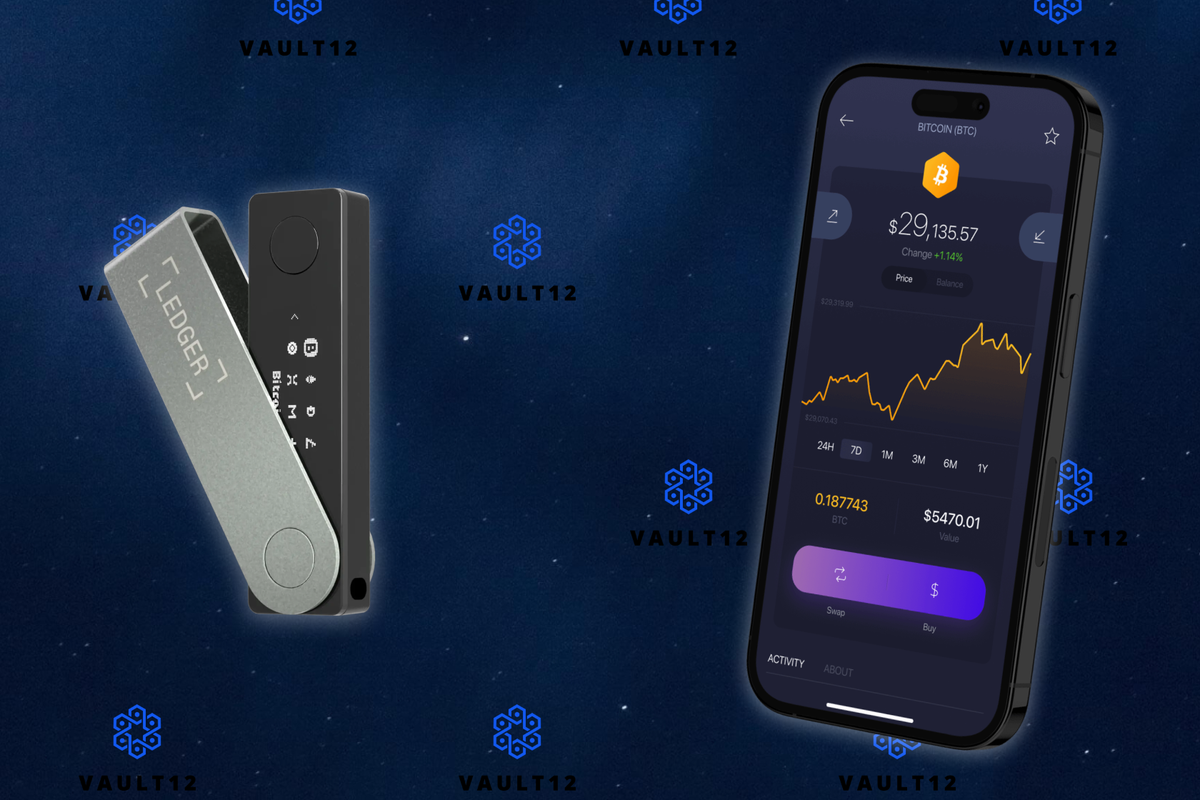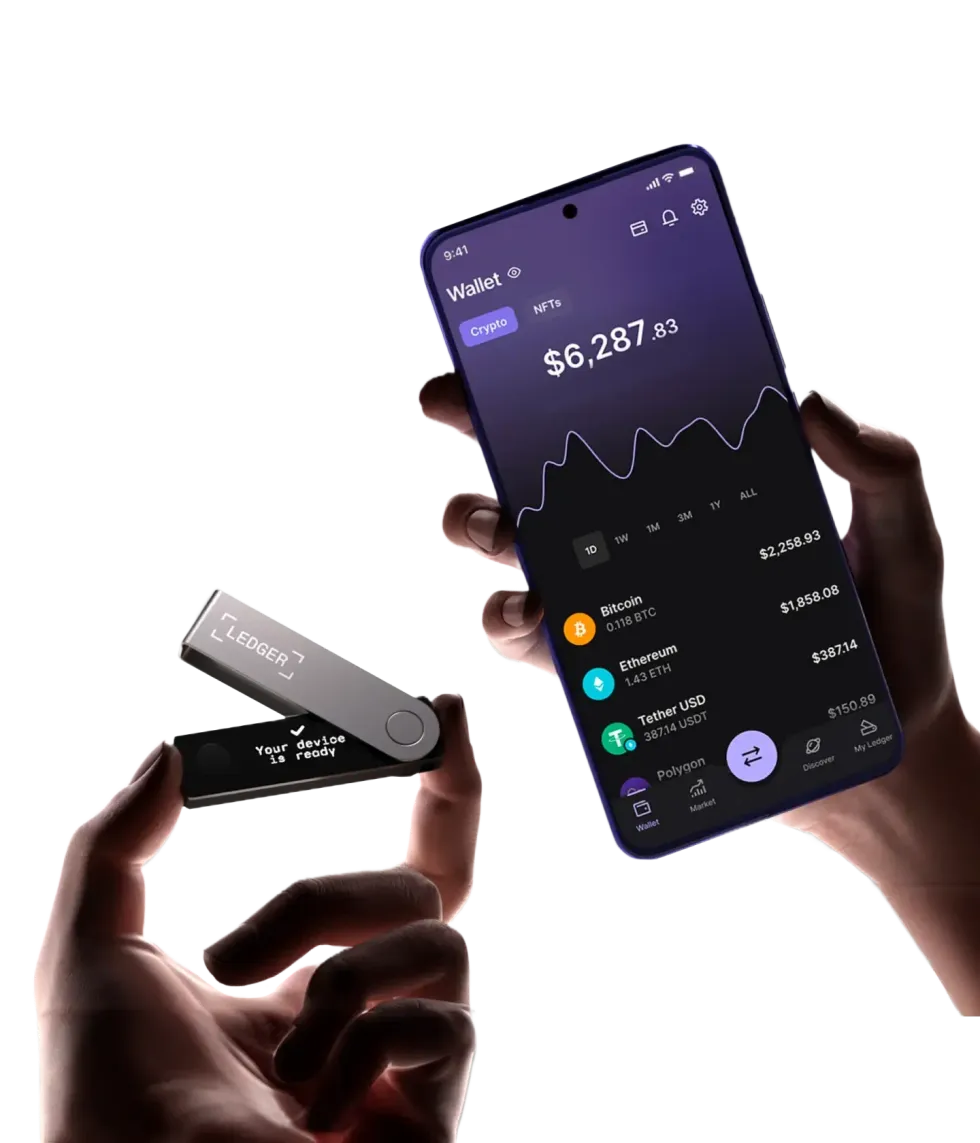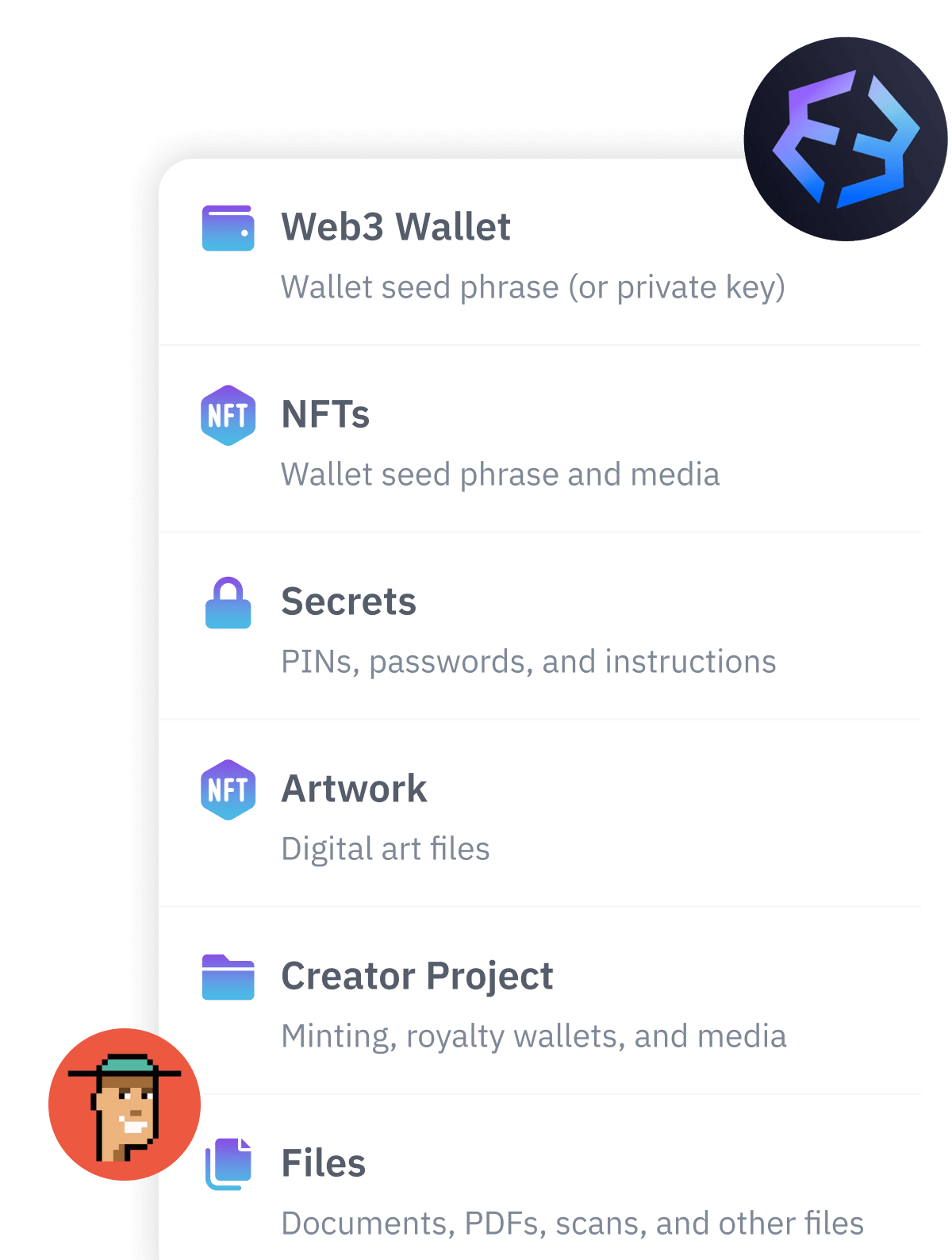
Contents
- Overview
- Approach to comparison
- What happens if your wallet is lost or stolen?
- How do these wallets handle Crypto Inheritance?
- Backup and recovery differentiators
- How easy are these crypto wallets to use?
- Crypto wallet user experience (UX) differences
- How do these wallets' security features compare?
- Crypto wallet security feature differentiators
- Summary of Ledger Nano X and Exodus Comparison
- Vault12 Guard: a decentralized solution for Crypto Inheritance
Which is a better wallet: Ledger Nano X or Exodus?
Consider both your short-term needs and the long-term protection of your assets
When choosing crypto wallets, many users base their decisions on day-to-day asset management needs and perceived wallet or device security. However, savvy crypto users first consider a wallet's ability to handle long-term security scenarios.
Long-term security includes expected essentials like backup and recovery tools, and often-overlooked features related to secure and fault-proof third-party recovery. Wait, what's third-party recovery? You can think of third-party recovery as your ability to allow crypto assets to be inherited by successors. All crypto investors should have a comprehensive security strategy for the full life cycle of their crypto assets.
Let's begin by helping you understand the pros and cons of the Ledger Nano X hardware wallet and the Exodus software wallet for day-to-day activities, as well as considering their ability to safeguard the long-term security of your assets.
Overview
The Ledger Nano X and Exodus wallets both provide a wide variety of features and support a broad spectrum of cryptocurrencies, making them suitable for diverse crypto portfolios.
At a high level, several differences are clear:
Ledger Nano X
- Form: A hardware wallet, with mobile-centric usability via Bluetooth.
- General Usability: User-friendly (with necessary trade-offs due to its more-robust security features).
- Design: Compact and durable. The de facto standard for securing transactions on desktops.
- Price Point: It's not free, like software wallets are.
Exodus
- Form: A software wallet, available in both mobile and desktop versions.
- General Usability: Easy to use, and has particularly well-reviewed customer support.
- Design: Built-in exchange features and a moderate number of integrations.
- Price Point: The wallet software is free; the company makes money on exchange services provided through the wallet.
The decision between the two will likely hinge on individual preferences for target security requirements, preferred platforms (mobile or desktop), and should take into account the planned frequency of use.
Approach to comparison
Now, let's have a closer look.
When choosing the best hardware wallet for cryptocurrency security, you may wonder not only which is better, the Ledger Nano X or the Exodus, but also:
- What happens if your wallet is lost or stolen? (How well can these wallets recover from user errors?)
- How do these wallets handle more advanced scenarios like inheritance of crypto assets?
- How easy to use are these wallets?
- How do their security features compare?
This article compares important characteristics for these two popular wallets. We’ll break down the strengths and weaknesses of each, focusing on security, ease of use, and backup and recovery methods. By the end of this comparison, you’ll clearly understand which wallet is right for you, as well as how to recover your crypto assets in case of accidents.
What happens if your wallet is lost or stolen?
Wise wallet owners recognize the critical importance of crypto recovery before they find themselves in an unexpected bind! That's why it's important to understand the fundamental topic of crypto asset longevity, including features such as backup, recovery, and inheritance for crypto assets. These considerations are central to long-term planning.
Technical security is essential, but in the world of crypto, the degree to which backup and recovery solutions are foolproof for users is at least equally important. Here are the backup and recovery options for these two wallets:
Ledger Nano X | Exodus | |
Backup & Recovery methods | Recommends Recovery Seed Phrase be written on paper, or engraved onto metallic plates. | Recommends Recovery Seed Phrase be written on paper, or using iCloud or Google Account saving it along with your everyday passwords. |
Optional paid subscription | Ledger Recover, a centralized 3rd-party cloud service, highly criticized by the crypto community. Clouds are not safe — especially when operated by multiple 3rd parties. | No. |
How do these wallets handle Crypto Inheritance?
Crypto Inheritance Features
Currently, most crypto wallets, including the Ledger Nano X and Exodus, lack any features for establishing and managing crypto inheritance. This gap presents a challenge for users who want to be sure that their crypto assets can be transferred to their heirs.
Ledger Nano X | Exodus | |
Backup |
- Written only | - Written only |
Inheritance | No | No |
Decentralized backup with Vault12 | Yes | Yes |
Inheritance Management with Vault12 | Yes | Yes |
Backup and recovery differentiators
Ledger Nano X Recover service Disadvantages:
- The optional Ledger Recover backup service is a paid service provided by three corporations that each hold parts of the user’s seed phrase in a cloud. This introduces risks, as the seed phrase could potentially be accessed via subpoena; or business partners could terminate agreements or become involved in lawsuits that result in locked data or resources (like, for example, Gemini and Genesis). These scenarios contain multiple potential points of failure.
- Very important detail: The terms of the optional Ledger Recover service do not mention support for inheritance, meaning any unfortunate accident related to the user could make crypto assets unrecoverable for his or her successors. Ledger itself suggests using 3rd-party crypto inheritance services for those purposes.
Ledger Nano X Recover service Advantages:
- People have different preferences. If a user is comfortable trusting a bank with their assets, they might also feel confident using Ledger Recover for securing their seed phrase backup (even though Ledger is not providing the entire cloud backup solution).
Exodus backup Disadvantages:
- Exodus has a cloud backup feature that comes with similar security assumptions and risks as all other passwords stored in your cloud provider. It is not recommended to rely on cloud backups for significant crypto balances.
Exodus backup Advantages:
- Exodus does offer a one-click solution for backup for insignificant balances of crypto.
How easy are these crypto wallets to use?
Let's compare the key aspects of both wallets side by side, and then summarize what really stands out for user convenience:
Ledger Nano X | Exodus | |
Display |
1” Monochrome OLED, | Full smartphone screen |
Input interface | 2 click buttons | Full smartphone screen |
Cable | USB-C | n/a |
Wireless | Bluetooth | As smartphone |
Platforms | macOS, Windows, Linux, Android, iOS, Browser Extension (3rd party) |
iOS, Android, Browser Extension |
3rd party wallets and dapps support | MetaMask, Exodus + 28 more | Ledger, Trezor |
Password manager & 2FA | FIDO2 2FA & Passkeys, Password Manager | n/a |
Product size & weight | 72 x 19 x 12 mm / 34g | - |
Convenience features | Battery (Up to 5 hours in use) | Exchange support |
Number of supported coins | 5,500+ | 200+ |
Price | $149 | $0 |
Crypto wallet user experience (UX) differences

Ledger Nano X with Smartphone UX
Ledger Nano X Disadvantages:
- The display is literally the size of a coin: very uncomfortable to use.
- Requires two-handed operation, making it difficult to use with a phone simultaneously — contrary to some misleading ads.
- The buttons are stiff, making operations cumbersome.
Ledger Nano X Advantages:
- Offers Bluetooth connectivity — works with or without a cable, at least with smartphones.
- Wide support for third-party wallets and dapps, allowing the Ledger Nano X to sign transactions directly in MetaMask, Uniswap, and other platforms without relying on Ledger Live software. This is a huge advantage for DeFi users.
Exodus UX Disadvantages:
- As a product that prioritizes ease of use, Exodus does not offer a full suite of advanced features such as fiat currency on/off ramps or advanced Web3 / DeFi integrations.
- The desktop version of Exodus offers more features than the mobile version (e.g., portfolio management tools, Trezor hardware integration, and a broader set of supported cryptocurrencies).
Exodus UX Advantages:
- Exodus is generally more user-friendly than the Ledger Nano X (and other hardware wallets).
How do these wallets' security features compare?
Now, we dive deeper into the core specification of every hardware wallet: security features.
| Ledger Nano X | Exodus | |
| PIN-code | 4 - 8 digits | up to 6 digits |
| BIP39 Passphrase | Yes | No |
| Open-source | Partial | Partial |
| Secure Element | Yes | No |
| Multisignature | Yes | No |
Crypto wallet security feature differentiators
Ledger Nano X security Disadvantages:
- Some critical components are closed-source. This raises concerns, especially after the controversial introduction of the Ledger Recover backup service, which challenged the previous assumption that the Secure Element could never transmit the recovery seed phrase outside the hardware wallet.
Ledger Nano X security Advantages:
- Includes a Secure Element, giving Ledger devices a strong reputation for withstanding physical attacks. This is important for users who prefer not to complicate their security with BIP39 passphrases, prioritizing ease of use.
Exodus security Disadvantages:
- Portions of the Exodus wallet are closed-source, preventing full transparency of its code security.
- Exodus, like all software wallets, operates in an inherently less-secure operating environment than a hardware wallet.
- As a software wallet, Exodus lacks a Secure Element.
- Exodus lacks support for some common security extensions such as 2-factor authentication, creation of multisignature transactions, and entry of a wallet "extra word" passphrase.
Exodus security Advantages:
- Some of Exodus's security disadvantages could be mitigated by using Exodus together (integrated) with Ledger Nano X (they are compatible with each other).
Summary of Ledger Nano X and Exodus Comparison
The Ledger Nano X and Exodus both provide a respectable set of features, and support a broad spectrum of cryptocurrencies, making them suitable for diverse crypto portfolios.
The Ledger Nano X is a mobile-friendly, security-oriented solution, and offers a balance of security and convenience features. It provides a small display and uncomfortable input, but with the advantages of a Secure Element and wireless connectivity options like Bluetooth.
On the other hand, Exodus is free and simple, but provides fewer security capabilities. It's great for beginning users and suitable for relatively small amounts of crypto.
The decision between the two will likely hinge on individual preferences for the target use case and balance, and should take into account the planned frequency of use.
Given their convenient integration, the best of all worlds could be to use both wallets, holding larger amounts of crypto in your Ledger Nano X wallet while keeping a small, ready-to-transact "petty cash" stash in your Exodus wallet.
Whichever you choose, remember to add crypto inheritance to your choice of wallet to ensure the long-term safety of your digital assets.
Vault12 Guard: a decentralized solution for Crypto Inheritance
Vault12 is the pioneer in Crypto Inheritance Management, and delivers an easy-to-use and secure method for assigning a legacy contact to your crypto wallets. This enables you to pass on your wallet seed phrases and private keys for all types of digital assets to future generations. Vault12 Guard is designed for everyday people, yet strong enough for Crypto OGs.
Vault12 Guard has a uniquely-secure design. Utilizing advanced encryption and decentralized storage, it ensures that crypto assets are not only safe but also transferable under predefined conditions, filling a critical need unmet by most traditional hardware wallets. Vault12 Guard applies a hybrid approach of software fused with the hardware-based Secure Element of phone devices (The Secure Enclave for iOS devices, and Strongbox for Google devices). Vault12 Guard's decentralized design reduces possible points of failure. Nothing is stored on cloud servers or Vault12 servers, and no assets are stored on local devices, making them less of a target.
From a user perspective, the Vault12 Guard app asks users to appoint one or more people (or mobile devices) as Guardians. The designated Guardians are entrusted to protect the user's comprehensive collection of wallet seed phrases and private keys, which are safely stored within a decentralized digital Vault. Its simple, user-friendly workflow removes the necessity for regularly revising wallet inventories or modifying instructions for your lawyers — a process that otherwise could lead to privacy breaches.
Both the Ledger Nano X and Exodus are compatible with Vault12 Guard Inheritance. This addresses the seed phrase backup dilemma for any hardware wallet. It also makes less-secure backup methods, such as paper or steel plates, unnecessary.
Which is a better wallet: Ledger Nano X or Exodus?
Consider both your short-term needs and the long-term protection of your assets

Vault12
Vault12 is the pioneer in crypto inheritance and backup. The company was founded in 2015 to provide a way to enable everyday crypto customers to add a legacy contact to their cry[to wallets. The Vault12 Guard solution is blockchain-independent, runs on any mobile device with biometric security, and is available in Apple and Google app stores.
You will lose your Bitcoin and other crypto when you die...
...unless you set up Crypto Inheritance today.
It's simple — if you don't worry about crypto inheritance, nobody else will — not your software or hardware wallet vendors, not your exchanges, and not your wealth managers. So it's up to you to think about how to protect the generational wealth you have created, and reduce the risks around passing that crypto wealth on to your family and heirs. What are the challenges with crypto inheritance?
- Crypto Wallets are difficult to use and do not offer crypto inheritance management. In fact, most of them tell you to write down your seed phrase on a piece of paper, which is practically useless.
- Some people back up their wallet seed phrases or private keys on paper, local devices like hardware wallets or USBs, or in the cloud. All of these options have severe drawbacks that range from hacking to accidental loss to disrupted cloud services.
- Software wallets operate on specific blockchains, yet your crypto assets span multiple blockchains. For inheritance to work, you must be able to manage inheritance across every blockchain — now and forever.
DISCLAIMER: Vault12 is NOT a financial institution, cryptocurrency exchange, wallet provider, or custodian. We do NOT hold, transfer, manage, or have access to any user funds, tokens, cryptocurrencies, or digital assets. Vault12 is exclusively a non-custodial information security and backup tool that helps users securely store their own wallet seed phrases and private keys. We provide no financial services, asset management, transaction capabilities, or investment advice. Users maintain complete control of their assets at all times.
Pioneering Crypto Inheritance: Secure Quantum-safe Storage and Backup
Vault12 is the pioneer in Crypto Inheritance, offering a simple yet powerful way to designate a legacy contact and pass on your crypto assets—like Bitcoin (BTC), Ethereum (ETH) and Solana (SOL) —to future generations. Built for everyday users yet robust enough for the most seasoned crypto enthusiasts, Vault12 Guard ensures your wallet seed phrases and private keys are preserved in a fully self-sovereign manner, across all Blockchains.
At the heart of Vault12 Guard is quantum-resistant cryptography and a decentralized, peer-to-peer network of trusted Guardians. Your critical information is never stored in the cloud, on Vault12 servers, or even on local devices—dramatically reducing the risk of a single point of failure. By fusing a powerful software layer with the Secure Element of iOS devices (Secure Enclave) and Google devices (Strongbox), Vault12 Guard locks down your private keys against present and future threats.
Our innovative approach harnesses social recovery, enabling you to appoint one or more trusted individuals or mobile devices as Guardians. These Guardians collectively safeguard your protected seed phrases in a decentralized digital Vault—so there’s no need for constant lawyer updates or bulky paperwork. Should the unexpected happen, your chosen legacy contact can seamlessly inherit your crypto assets without compromising your privacy or security.
Preserve your digital wealth for generations to come with Vault12 Guard—the simplest, most secure way to manage crypto inheritance and backup.
Take the first step and back up your crypto wallets.
Designed to be used alongside traditional hardware and software crypto wallets, Vault12 Guard helps cryptocurrency owners back up their wallet seed phrases and private keys (assets) without storing anything in the cloud, or in any single location. This increases protection and decreases the risk of loss.
The first step in crypto Inheritance Management is making sure you have an up-to-date backup.
The Vault12 Guard app enables secure decentralized backups, and provides inheritance for all your seed phrases and private keys across any blockchain, including Bitcoin, Ethereum, and others, and for any crypto wallet.
Note: For anyone unfamiliar with cryptocurrencies, Vault12 refers to wallet seed phrases and private keys as assets, crypto assets, and digital assets. The Vault12 Guard app includes a software wallet that works alongside your Digital Vault. The primary purpose of this is to guard your Bitcoin (BTC) and Ethereum (ETH) wallet seed phrases, private keys, and other essential data, now and for future generations.











